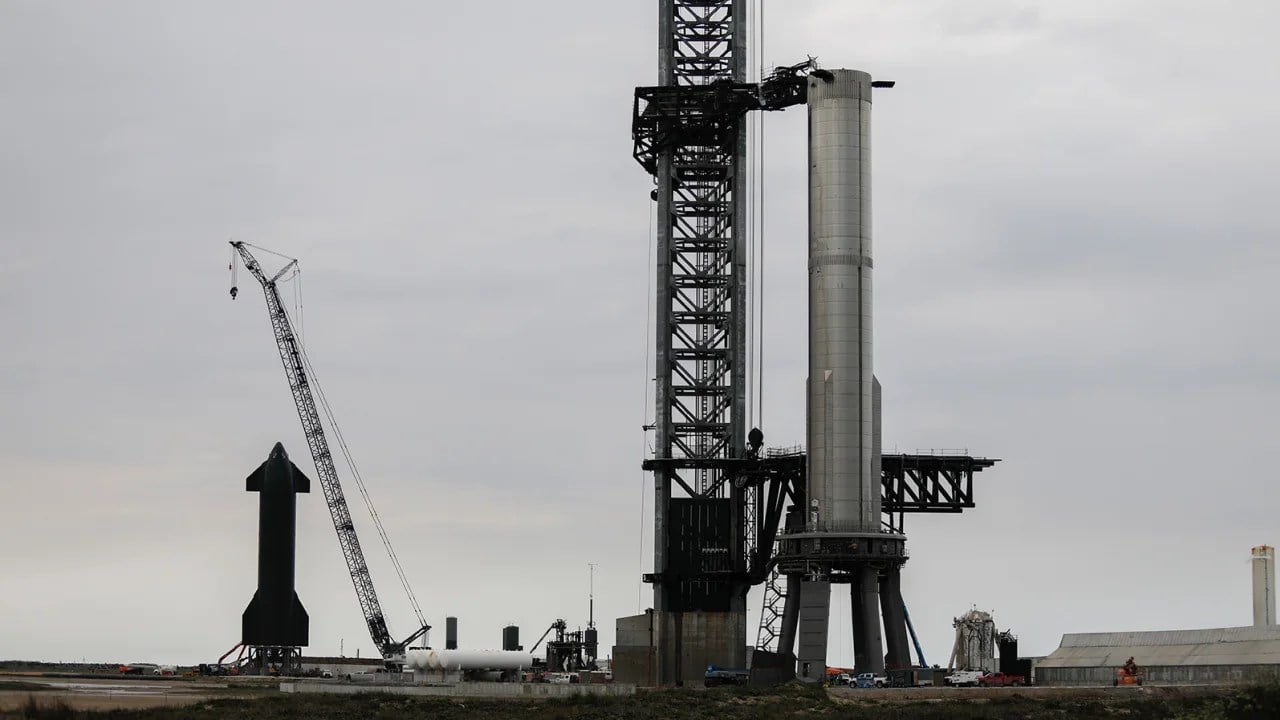To the Moon, Mars & beyond: SpaceX Starship set for first test flight
At 8:00 am Central Time (1300 GMT), the giant rocket is planned to take off from Starbase, the SpaceX spaceport in Boca Chica, Texas.
-

SpaceX workers on February 8 make final adjustments to Starship's orbital launch mount. (AP)
SpaceX is preparing to set off the first test flight of Starship, which is reportedly designed to send astronauts to the Moon and Mars and beyond.
At 8:00 am Central Time (1300 GMT), the giant rocket is planned to take off from Starbase, the SpaceX spaceport in Boca Chica, Texas.
If Monday's launch attempt is postponed, fallback times are planned for later in the week, which billionaire SpaceX creator Elon Musk says is a distinct possibility.
"It's a very risky flight," Musk said in a live event on Twitter Spaces on Sunday. "It's the first launch of a very complicated, gigantic rocket."
T-12 hours until the first flight test of a fully integrated Starship and Super Heavy rocket; targeting ~8:00 a.m. CT for liftoff → https://t.co/bJFjLCilmc pic.twitter.com/dZTNuOnKPr
— SpaceX (@SpaceX) April 17, 2023
"There's a million ways this rocket could fail," he added. "We're going to be very careful and if we see anything that gives us concern, we'll postpone."
Musk said he wanted to "set expectations low" because "probably tomorrow will not be successful -- if by successful one means reaching orbit."
For the first time since the Apollo program ended in 1972, the US space agency NASA has chosen the Starship spacecraft to carry men to the Moon in late 2025. This mission is known as Artemis III.
Starship's flight test window opens at 7:00 a.m. CT tomorrow; a live webcast will begin ~45 minutes before liftoff → https://t.co/bG5tsCUanp pic.twitter.com/mBGaFNwhaU
— SpaceX (@SpaceX) April 16, 2023
Starship includes a 50-meter tall spacecraft drafted to carry crew and cargo that sits atop a 230-foot tall first-stage Super Heavy booster rocket.
The spaceship and the Super Heavy rocket, collectively known as Starship, have never taken off together, despite the spacecraft's several sub-orbital test flights on its own.
Approximately three minutes after launch, if everything goes as planned, the Super Heavy rocket will separate from Starship and splash down in the Gulf of Mexico.
The six-engined Starship will continue to ascend to a height of close to 150 miles before making a nearly complete rotation of the planet and splash down in the Pacific Ocean roughly 90 minutes after launch.
"If it gets to orbit, that's a massive success," Musk said.
"If we get far enough away from the launchpad before something goes wrong then I think I would consider that to be a success," he said. "Just don't blow up the launchpad.
"The payload for this mission is information," he said. "Information that allows us to improve the design of future Starship builds."
'Objective is to establish bases on the Moon and Mars'
SpaceX held a successful test-firing of the 33 Raptor engines on the first-stage booster of Starship back in February.
During the test-firing, also known as a static fire, the Super Heavy rocket was attached to the ground to stop it from taking off.
In November 2024, NASA will send astronauts to the moon on its own, using the Space Launch System (SLS), a hefty rocket that has been in development for more than ten years.
More than twice as much thrust as the Saturn V rockets used to launch the Apollo astronauts to the Moon, it produces 17 million pounds of thrust.
In the future, SpaceX plans to launch a Starship into orbit, refuel it with another Starship, and then send it on its way to Mars or beyond.
Musk said the goal is to make Starship reusable and bring down the price to a few million dollars per flight.
"In the long run -- long run meaning, I don't know, two or three years -- we should achieve full and rapid reusability," he said.
The eventual objective is to establish bases on the Moon and Mars and put humans on the "path to being a multi-planet civilization," Musk said.
"We are at this brief moment in civilization where it is possible to become a multi-planet species," he said. "That's our goal. I think we've got a chance."
Read more: China will launch 12,992 satellites into orbit to rival SpaceX

 4 Min Read
4 Min Read










